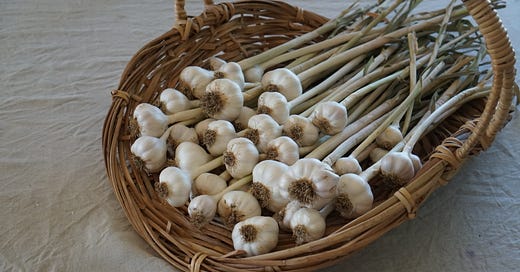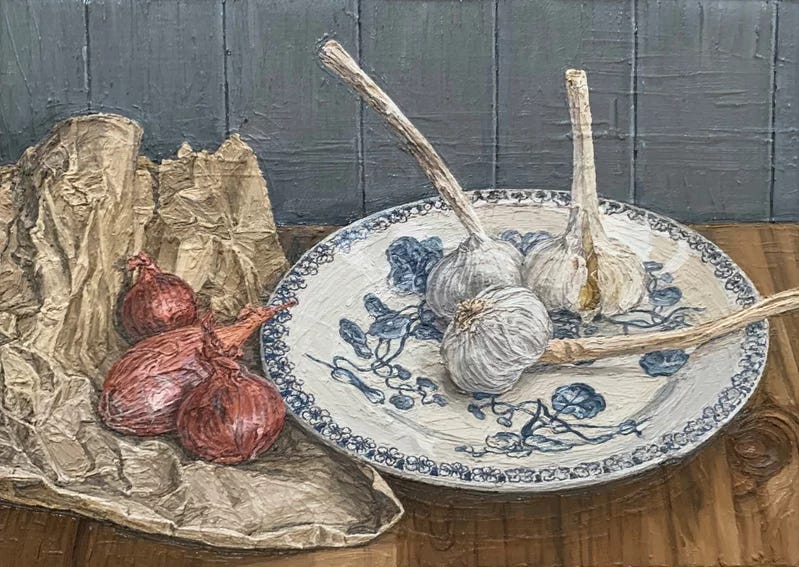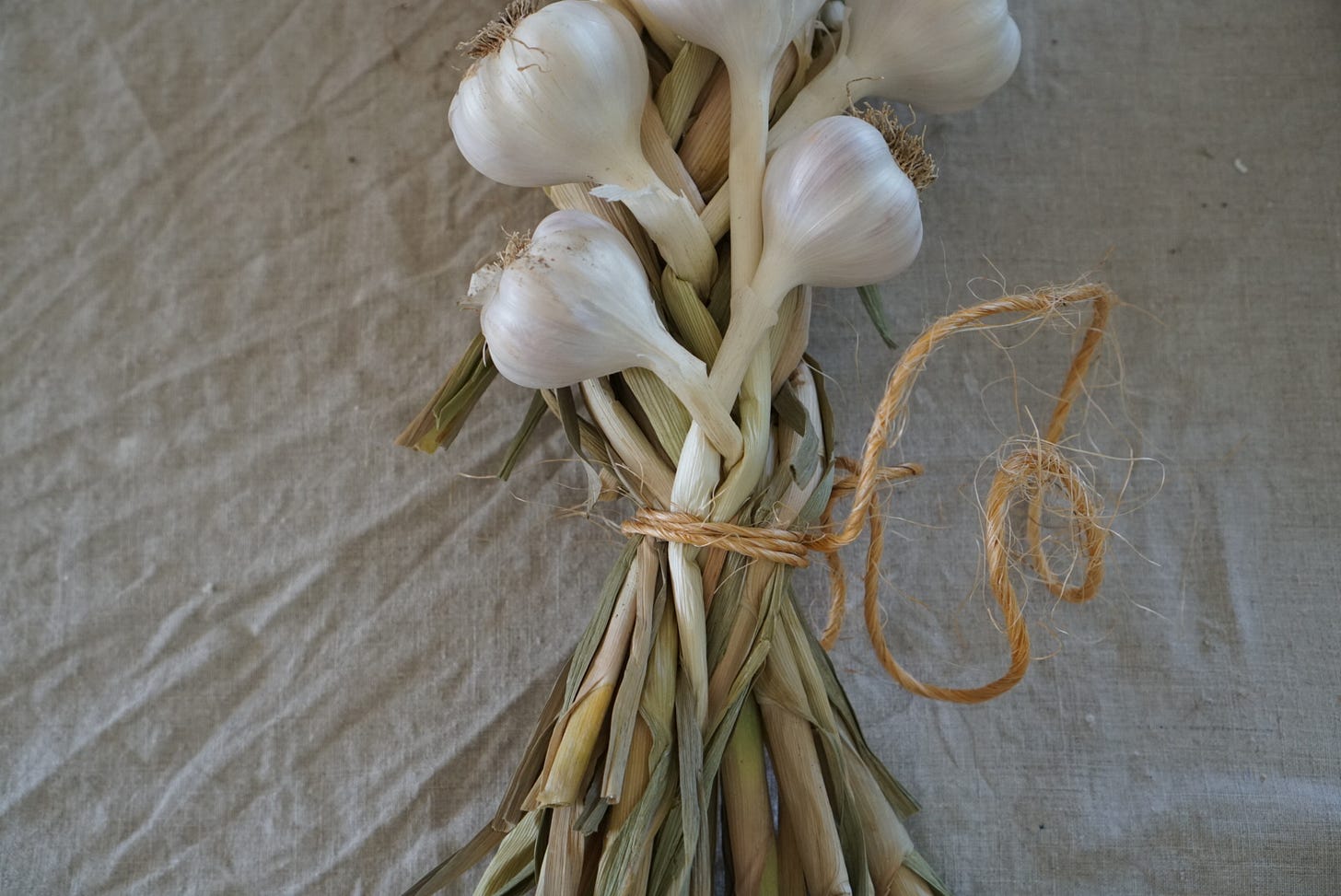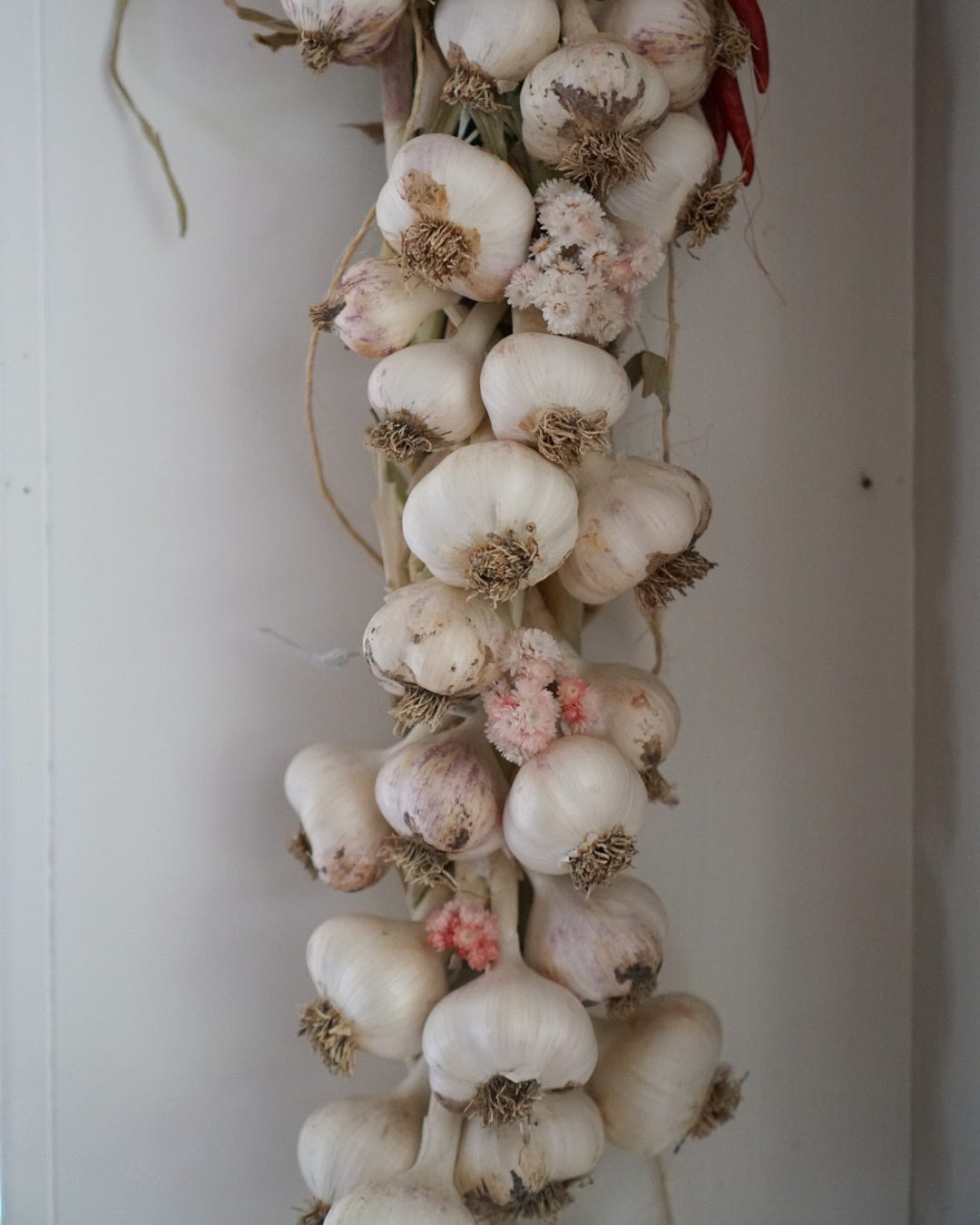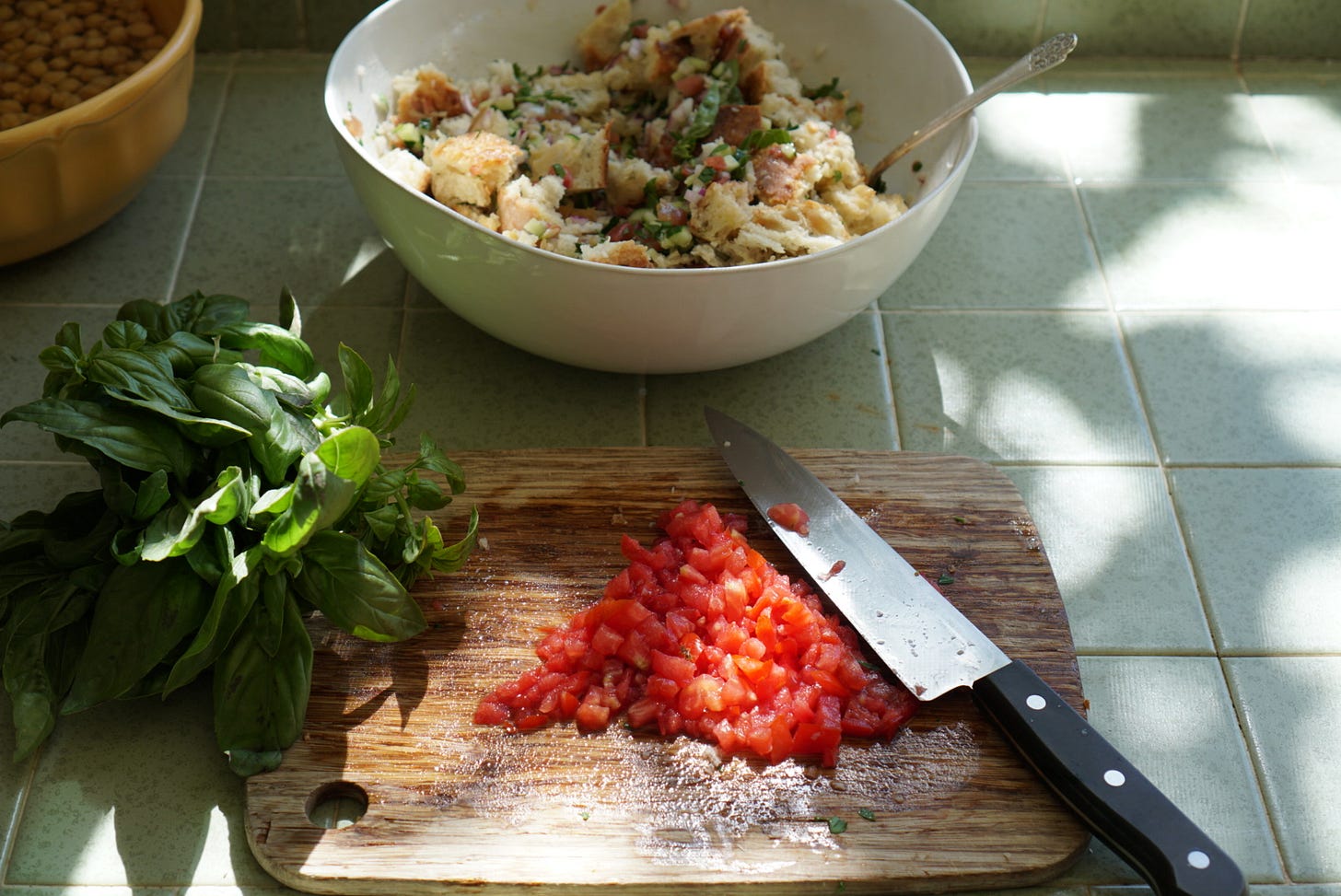Welcome to mama eats, a twice-weekly newsletter (Tues. & Sat.) inspired by a simple + seasonal home life. This week’s post about braiding garlic is free to read, barring the recipe for panzanella at the end, which is viewable by paid subscribers. I try to provide as much free content as possible, however, this newsletter is a labor of love and I am a busy mother of three. If you have the means and find value in what I share, please consider becoming a paid subscriber, which also gives you the benefit of access to the growing archive (posts over a month old).
note to readers: the first part of this post was originally written for my blog in June 2020, now edited and with additional words and photos added June 2024.
We have been sinking into these quiet, lazy days of summer. It has been hot, which means I fling all the windows open early in the morning, go out to do any gardening and harvesting work, then come in and close the windows to keep the house cool the rest of the day. Our days are mainly filled with reading, swimming and cooking, with the odd outing to outside places- we went a berry farm to pick marionberries and blueberries last week, and sometimes venture to the creek, or on a hike. We are missing and mourning seeing friends and family in the usual ways we are used to, but are grateful for everything we do have. The news breaks my heart every day, giving me the feeling of being stuck inside a washing machine, knocked about, choking on the same thing coming over and over again, todays bruises layering on top of yesterdays. Enough to dull your soul and let out a whimper.
A calm spot in these troubled seas, for me, is always found in keeping my hands busy. One of the things I’ve busied them with lately is braiding garlic. I harvested it a while back, usually I go for it when the outer skin on the bit of the garlic near the ground feels a bit dry and the tops are slightly yellowed. For me (in California), this is usually early or mid June. I pull them all up and trim their roots, then pull off an outer layer or two to shed the dirt- underneath, they are as luminous and silver white as the moon. I lay them over the work table in the garage to dry out a bit. It’s nice and warm in there but no direct sunlight, which helps them to dry without molding.
Once they have papery skin over the bulb part, but still have a flexibility to the stalk (not fully dry) is when I like to braid them. Even though the stems in the pictures below look dry, they are actually quite bendy still on the inside. This is my second year braiding, last year I tried it and it worked a treat, I had it hung in a darker corner of my kitchen and they lasted almost a whole year. The braid separates the heads and provides good air circulation to prevent rot/mold. Of course, it also looks beautiful, which is important, too.
It’s quite a simple job to braid garlic, if you can braid hair you can easily do it. Really the trick is not letting the stems get too dry, otherwise they will be brittle and crumble when you try to braid them. You start with three of the largest bulbs, one in the middle, and two on either side, their stems forming an X over the first garlic. These you tie together with a good long length of sturdy twine (I use jute). The length of the string gets braided along with the stems to give support when hanging. Then you begin to braid, just as you would hair, using the largest bulbs first. Left tail, right tail, add a new garlic to the center tail, repeat. Make sure the string keeps getting braided, too. At the end, wind the twine a few times around the top and tie it firmly. Tie a loop at the top of the string to hang it with, and voila, you have a lovely garlic braid, both useful and beautiful.
Hang in a spot that doesn’t get direct sunlight. One of mine is hung on the side of my cabinet, another on the cookbook bookshelf. I meant to do a video of braiding it, as I know its helpful to see the whole thing happen, but I didn’t get to it. However, there are loads of good youtube videos about it, an especially helpful one is here. Also, there are tighter and fancier ways of braiding, but I prefer the simplicity and airflow that this way provides.
I find garlic to be an extremely special ingredient. It is so beautiful, luminous in its delicate tissue wrapping, while also being humble and strong and the backbone of so many of our dishes. I wrote about an especially cherished garlic braiding year in 2022:
Last weekend I pulled all the garlic I planted in September. When I planted them, I had just birthed a tiny human a month before, him bound tightly to my body in a wrap as I undressed the tissue parcels of garlic, laying bare each clove, to plant into the waiting ground. Then, watching over it as it grew- here as small as a blade of grass, here tall and green in the rain, here with tips crinkling yellow under the sun. Then last week I eased it out of the ground, 9 months later, another birth- the bulbs round and papery and glowing white, luminous as pearls. Bots of soil clinging to roots, ready to dry in the hot hot heat of early summer. They dried a few days in the garage, then were coaxed and braided into shape by my hands, alongside a friend braiding the garlic she grew, while we laughed and chatted and complained and the wind blew the chaff from the stems around our feet in a swirl that mirrored our thoughts, our worries. Braids heavy and full, tenderly tucked with flowers, ready to play a supporting role to cooking the rest of the year. The most humble and beautiful ingredient, growing garlic always seems so special to me. As good as ten mothers.
As a little aside, I would love to recommend the film, Garlic Is as Good as Ten Mothers, directed by Les Blank, from 1980. It is an ode to garlic and “interviews garlic fanatics of all stripes”, including Alice Waters.
This new garlic is fresh, juicy and with a gently sweet heat- a complete contrast to long stored garlic, which can be extremely pungent. It is so good for flavoring the fresh new vegetables of summer with- it supports and brings their flavors into focus, rather than overpowering them- the new tender zucchini, the first fresh tomato sauces, even sliced thinly and generously atop a pizza with red sauce- and especially good in panzanella.
Panzanella is a classic cucina povera dish of Tuscany, something made of nothing- a way to make stale bread palatable. It is an ancient one, mentioned in 14th century literature, and praised highly by Rennaissance painter and poet Bronzino, “Those who wants to reach the melody of the stars above, add the olive oil and vinegar to the wet bread and gorge yourself with it. A salad made with minced onions and cucumbers is the highest pleasure in life, and consider what would happen if to this salad I add also basil and arugula...”
Indeed, this is a heavenly dish and one that I make often in the summer, anytime there’s some stale bread to use up. If fresh, juicy, violently red summer tomatoes haven’t made it to your area yet, don’t despair- I make this early in the season, too, without them- panzanella was made before tomatoes began to be used regularly in Italy, well into the sixteenth century, and thus did not include them until then. Although it can be made any time of year- I’ve made it in winter with just red onion, parsley, garlic, olive oil, vinegar and salt- it’s a perfect summer dish, as it doesn’t require any heat to prepare, it’s simple to make, and it can sit at room temperature, which works well for picnics and the like. I like to prepare it right after breakfast for lunch.

